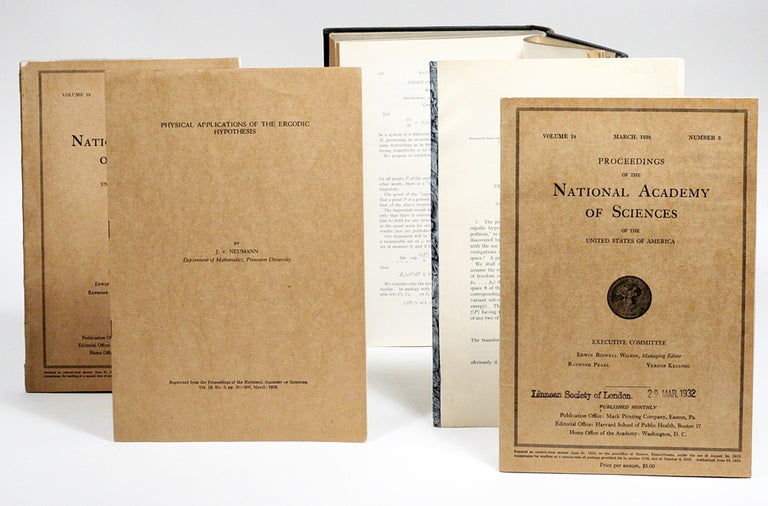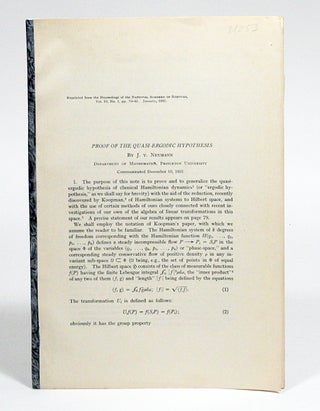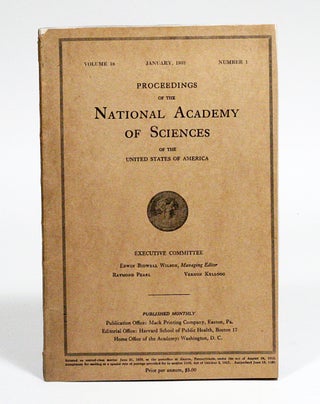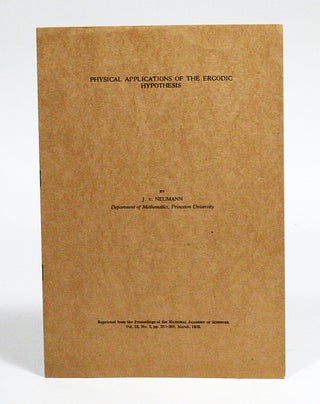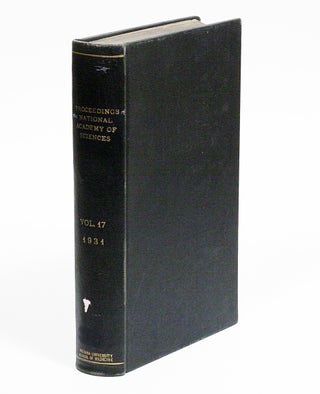Proof of the Ergodic Theorem. WITH: Proof of the Quasi-Ergodic Hypothesis. WITH: Physical Applications of the Ergodic Hypothesis. WITH: Recent Contributions to the Ergodic Theory
“I have sometimes wondered whether a brain like von Neumann’s does not indicate a species superior to that of man.” –Hans Bethe, quoted in Clay Blair, Jr., “Passing of a Great Mind”, Life Magazine (February 25, 1957)
“This very distinguished philosophy professor came out on the platform in front of this gang of students and took a bit of chalk and scrawled up a proposition in symbolic logic on the board. He turned to his audience and said, ‘Well now, ladies and gentlemen, I think you’ll agree that that’s obvious?’ Then he looked at it a bit more and started to scratch his head and after a while he said, ‘Excuse me!’ And he disappeared. About half an hour later he came back beaming all over his face and said triumphantly, ‘Yes, I was right — it is obvious!’” –John Brunner, “Stand on Zanzibar” (1968)
IMPORTANT PAPERS – IN BOTH OFFPRINT AND JOURNAL FORMATS – RELATED TO VON NEUMANN’S PROOF OF THE ERGODIC THEOREM, A FUNDAMENTAL CONTRIBUTION TO OUR UNDERSTANDING OF THE FOUNDATIONS OF STATISTICAL MECHANICS AND THE ORIGINS OF THE SECOND LAW OF THERMODYNAMICS.
In 1877 the great physicist Ludwig Boltzmann published a paper that sought to explain why systems tend toward maximum-entropy equilibrium states as predicted by the Second Law of Thermodynamics. The conceptual essence of the 1877 paper was this: a system — say, a gas in a container — can exist in any of an inconceivably large number of “states,” each differing from all others in the precise position or velocity of at least one molecule. In modern terminology, each such distinguishable disposition of the molecules of a physical system is called a “microstate”. But enormous numbers of microstates are equivalent in macroscopic terms — although they differ in terms of the precise locations and velocities of specific molecules, they look the same from the perspective of bulk thermodynamic variables such as temperature and pressure. In other words, such microstates are part of the same “macrostate.” The key to Boltzmann’s 1877 analysis was his recognition that the maximum-entropy state of a system — i.e., its equilibrium state — is precisely the macrostate that is consistent with the largest number of microstates. (This can be shown by a rather elementary application of combinatorial analysis, which Boltzmann undertook in the 1877 paper.) Accordingly, it is overwhelmingly more probable than not that a system — as it transitions from one microstate to the next — will eventually wind up in one of the microstates corresponding to the equilibrium macrostate.
There was, however, important gap in Boltzmann’s magisterial 1877 analysis — a gap that Boltzmann failed to recognize or, at least, to acknowledge. This was the implicit assumption that each microstate is equally probable — in other words, that as a system evolves in accordance with the fundamental laws of molecular mechanics, it will, on average, spend an amount of time in each macrostate that is proportional to the number of microstates in the macrostate. To restate the matter using more technical terminology, the assumption is that the fraction of time the system spends in each macrostate is proportional to that macrostate’s “volume” expressed as a fraction of the total accessible volume of the “phase space” for the system. (A “phase space” is an abstract multidimensional space representing all possible microstates of a physical system.) That assumption, in turn, is a consequence of what is now generally referred to as the “ergodic hypothesis.” The hypothesis had been an explicitly-acknowledged or implicitly-assumed element of Boltzmann’s reasoning about the statistical behavior of molecules from the first time he articulated it in a series of papers in the 1860s. But — despite several attempts — Boltzmann never offered any persuasive argument that real systems of molecules do display ergodic behavior, and at times he expressed doubt as to whether the hypothesis was even true.
Ever since Boltzmann’s 1877 tour de force, mathematicians and physicists have been attempting to justify the ergodic hypothesis — to show that it accurately describes the statistical behavior of molecules moving about in conformity with the fundamental laws of mechanics (whether classical or quantum). This is among the “set of issues that continue to plague the foundations of the theory [of statistical mechanics]” (Lawrence Sklar, “Physics and Chance: Philosophical Issues in the Foundations of Statistical Mechanics” (1993)). It was the problem that the mathematician John von Neumann tackled in the papers offered here.
“Von Neumann [1903-1957] may have been the last representative of a once-flourishing and numerous group, the great mathematicians who were equally at home in pure and applied mathematics and who throughout their careers maintained a steady production in both directions. … [I]n a profession where quick minds are somewhat commonplace, his amazing rapidity was proverbial. There is hardly a single important part of the mathematics of the 1930’s with which he had not at least a passing acquaintance, and the same is probably true of theoretical physics.” (DSB). His important contributions to pure and applied mathematics include the theory of Hilbert spaces, his axiomatization of quantum mechanics, and his pioneering work in game theory, in quantum statistics and thermodynamics, in numerical analysis, in the theory of computer architecture, in the theory of automata, and in game theory.
Essentially, what von Neumann demonstrated in the offered papers is that the ergodic hypothesis is equivalent to an assumption called “metric indecomposability,” or “metric transitivity.” In simple, intuitive terms, and omitting some technical qualifications, a physical system is metrically indecomposable (or transitive) if it evolves in such a way that regardless of its initial microstate, it will not remain confined within any sub-region of the system’s phase space. Von Neumann showed that a metrically transitive system will have properties whose average over time is equal to the average value of those properties over the phase space of all possible microstates. And that, in turn, is sufficient to underwrite Boltzmann’s conclusion that the equilibrium macrostate, representing the overwhelmingly largest percentage of a phase space, is ipso facto the most probable macrostate.
Von Neumann communicated his results to George Birkhoff prior to publication, and Birkhoff managed to prove a sharper, stronger version of von Neumann’s theorem (the “pointwise” ergodic theorem v. von Neumann’s “mean” ergodic theorem), which, through the vagaries of the publication process, appeared before von Neumann’s paper. In March 1931, two months after von Neumann’s proof was published, von Neumann and Birkhoff published two separate papers in Proceedings of the National Academy of Sciences comparing the two proofs. (The March 1931 issue of PNAS is included among the items offered here.) Von Neumann’s paper (“Physical Applications of the Ergodic Hypothesis”) noted that “it is of interest to decide which of the two formulations [von Neumann’s or Birkhoff’s] corresponds to the actual physical problem of the ergodic hypothesis. It turns out that the weaker form [i.e., that proved by von Neumann] is sufficient, — that it, indeed, is the precise mathematical equivalent of the physical state of affairs.” Birkhoff’s paper, co-authored with B.O. Koopman, provided a detailed summary of the history of the Ergodic Hypothesis, noted that “[t]he first one actually to establish a general theorem bearing fundamentally on the Quasi-Ergodic Hypothesis was J. v. Neumann …”, acknowledged that von Neumann had communicated his results to Birkhoff in October 1931, and recognized that “[f]rom the point of view of the gross statistics on [the phase space],” the two theorems are identical, but claimed that Birkhoff’s result was “fundamentally more far-reaching.”
“One presumes that [Birkhoff] sent copies [of his 1931 paper] to Koopman and von Neumann, who would have noticed that Birkhoff had not given von Neumann adequate credit and recognition for his result. Von Neumann evidently planned to include his ergodic theorem and its proof in a much longer paper he was writing for the Annals of Mathematics, but he then apparently quickly drafted a short paper for PNAS with his proof of the mean ergodic theorem and submitted it to PNAS on December 10, 1931. It appeared in the January 1932 issue. One suspects that these events led Koopman and Birkhoff to write and publish their [March 1932] paper in PNAS …, which set matters straight and clearly acknowledged von Neumann’s priority.” (Calvin C. Moore, “Ergodic Theorem, Ergodic Theory, and Statistical Mechanics”, in Proceedings of the National Academy of Sciences, 112(7): 1907-11 (2015)).
Von Neumann’s paper did not seek to prove that any particular physical systems were in fact metrically transitive. Indeed, “metric indecomposability … is itself extremely difficult to establish for realistic models.” (Sklar, op cit.). For this reason, some have criticized the von Neumann/Birkhoff ergodic theorem as an exercise in question begging — a way of restating the problem without solving it. (Birkhoff himself stated, in the 1932 paper offered here, that “the outstanding unsolved problem in the ergodic theory is [now] the question of the truth or falsity of metrical transitivity for general Hamiltonian systems. In other words, the Quasi-Ergodic Hypothesis has been replaced by its modern version: the Hypothesis of Metrical Transitivity.”) But by providing a precise mathematical criterion for identifying the type of dynamical behavior that would provide an adequate underpinning for statistical mechanics (and therefore for thermodynamics), von Neumann’s paper defined a goal, created an approach, and initiated a research program that has since taken great strides in identifying specific types of model systems that do demonstrate ergodic behavior and specific types that do not. (The work of Yakov Sinai is notable in the first category; and the “KAM” theorem of Andrei Kolmogorov, Vladimir Arnold, and Jürgen Moser is notable in the second.) See H Scott Dumas, “The KAM Story: A Friendly Introduction to the Content, History, and Significance of Classical Kolmogorov-Arnold-Moser Theory” (2014), pp 168-71, for a crisp summary of the current state of play. See also section 6 of Jos Uffink, “Compendium of the Foundations of Classical Statistical Physics”, in Jeremy Butterfield & John Earman, “Philosophy of Physics” (2007).
These efforts to determine what types of systems might behave ergodically have come far since 1932, but have a long way yet to go. There still exists no general proof that ergodic behavior predominates in all or most “physically realistic” model systems. “The nagging questions still nag, and even proliferate.” (Dumas, op cit., p. 171.) Indeed, some continue to question the “explanatory relevance” of ergodic theory — that is, whether ergodicity is even necessary or sufficient as a support for statistical mechanics. See, e.g., John Earman and Micklós Rédei, “Why Ergodic Theory Does Not Explain the Success of Equilibrium Statistical Mechanics”, Brit J. Phil. Sci. 47: 63-78 (2996); David B. Malament and Sandy L. Zabell, “Why Gibbs Phase Averages Work — The Role of Ergodic Theory”, Philosophy of Sci., 47:339-49 (1980), and Moore, op cit.
As a foundational issue for an important branch of physics, the existence, necessity, and sufficiency of ergodicity continues to be an issue of great importance to many physicists, mathematicians, and philosophers of science, whose work continues to build on the foundation put in place by von Neumann’s theorem.
The Collection:
– Proof of the Quasi-Ergodic Hypothesis (von Neumann). IN: Proceedings of the National Academy of Science, Vol 18, Issue 1, pp. 70-82. Octavo, the entire issue in original wrappers. Minor creasing, small chip at spine end, generally fine. WITH: The offprint of the same article, without wrappers and with a new spine. Easton, PA and Washington, DC: National Academy of Sciences, 1932.
– Physical Applications of the Ergodic Hypothesis (von Neumann). WITH: Recent Contributions to the Ergodic Theory (Birkhoff and Koopman). IN: Proceedings of the National Academy of Science, Vol 18, Issue 3, pp. 263-66; 279-292 . Octavo, the entire issue in original wrappers. 1932 stamp of the Linnean Society of London on front wrapper, otherwise fine. WITH: The offprint of von Neumann’s “Physical Applications...” in fine condition in original wrappers. Easton, PA and Washington, DC: National Academy of Sciences, 1932.
– Proof of the Ergodic Theorem (Birkhoff). IN: Proceedings of the National Academy of Science, Vol. 17, pp. 656-660. Octavo, the entire bound volume 17 in library cloth from the Indiana School of Medicine, with bookplate, “due date” slip, and spine stamp. Some marks to binding, text fine.
AN IMPORTANT COLLECTION WITH THE MAJOR PAPERS IN RARE JOURNAL AND OFFPRINT FORMATS.
Price: $4,300 .


